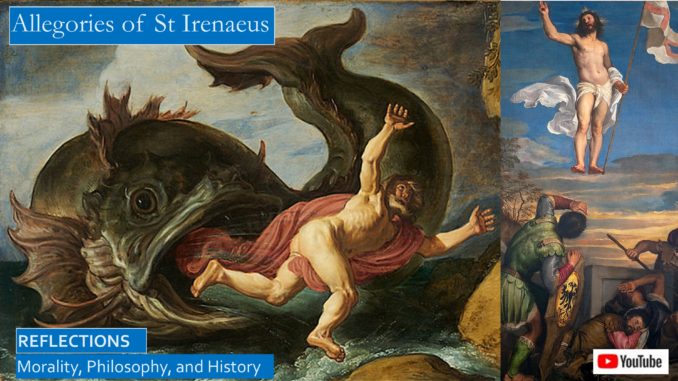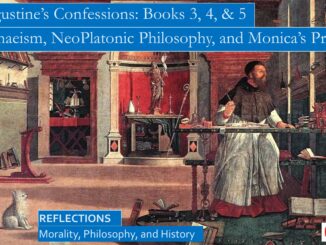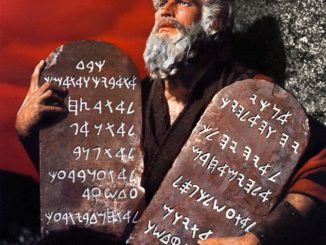
St Irenaeus includes a retelling of many of the parables of the New Testament as well as many stories of the Patriarchs and Moses in the Old Testament. He also quotes extensively from the prophets, especially Isaiah and Jeremiah, and Daniel and Revelations. He covers the story in Daniel of the three young men thrown into the furnace. Many of these stories are told elsewhere, and although an ambitious scholar can study how the interpretations of these stories evolved from St Irenaeus’ original interpretations, we are going to concentrate on the allegorical interpretations of St Irenaeus. Although St Irenaeus may be the first of the Church Fathers known to write about these allegories, no doubt most were passed down orally from his predecessors.
St Irenaeus Introduction, and examples of allegories in Luke and St Paul in Galatians:
http://www.seekingvirtueandwisdom.com/st-irenaeus-blog-3-allegorical-interpretations-of-scripture/
St Irenaeus Blog 1 http://www.seekingvirtueandwisdom.com/st-irenaeus-blog-1-against-heresies-introduction/
St Irenaeus Blog 2 http://www.seekingvirtueandwisdom.com/st-irenaeus-blog-2-against-heresies/
St Irenaeus sees Jonah as a type of Christ. God called Jonah to preach to the Ninevites so they would confess for their wicked ways, so Jonah boarded a boat going the opposite direction, he did not want for the mortal enemies of the Jews to repent and escape God’s wrath. The boat set sail, the winds and the waves grew angry, the crew drew lots to reveal who was the cause of the divine wrath, and the lot fell on Jonah. Over the railings they threw Jonah, to be swallowed by the whale. Jonah sung a psalm to the Lord, and “the Lord spoke to the fish, and it spewed Jonah out upon the dry land.”[1]
The best place to purchase the eBook version of the Ante-Nicene Fathers, Volume 1, is http://www.christianbook.com
St Irenaeus sees Adam as prefiguring Jonah. “From the beginning God permitted man to be to be swallowed up the great whale, who was the author of transgression, not that he should perish altogether” in the depths of the sea, but he would be saved by the plan of salvation, which was accomplished by Christ, the Word of God, “by the sign of Jonah.” “This was done that man, receiving an unhoped for salvation from God, might rise from the dead and glorify God, and repeat the words that Jonah prophesied in the belly of the whale, ‘I cried by reason of mine affliction to the Lord my God, and He heard me from the belly of hell.’ “[2]
After Adam and Eve had eaten of the apple they were ashamed and hid, weaving coverings of fig leaves, a rather itchy leaf. St Irenaeus tells us, “Adam adopted a dress suited for his disobedience, awed by the fear of God,” which is the beginning of wisdom, “waiting for God’s coming.” By his dress he admits to himself, “I by disobedience lost that robe of sanctity which I had from the Spirit, I do now acknowledge that I am deserving” of such uncomfortable dress, which tortures the body. God, who is merciful, clothes them instead in a more comfortable tunics of skins of fur. They were then driven out of Paradise and the Tree of Life because “God pitied them and did not desire that he should continue a sinner forever, nor that his sins become immortal.” God set a limit to his sin by imposing death, “so that man, ceasing at length to live to sin, and dying to it, might begin to live in God.” There would be life in Christ, as St Paul exhorts, “O death, where is thy victory? O death, where is thy sting?”[3]
St Irenaeus sees in the original disobedience an allegory of heresy. “The Church has been planted as a garden in this world, and the Spirit of God says, ‘You may freely eat from every tree of the garden,’ that is, you can partake of every word of Scripture of the Lord, but you shall not partake with any heretical discord,’ warning man from harmful speculation and realizing the danger of forming “opinions beyond the limits of understanding.”[4]
St Irenaeus saw many of the stories of the patriarchs as allegorical. When Rachel gave birth to Esau and Jacob, the infant Jacob grabbed the heel of Esau, and later Jacob would receive the blessing of the firstborn, though he was not the eldest brother, for Esau would sell his birthright for a bowl of porridge. The allegory was that the younger nation, the Gentiles, received Christ while the elder nation, the Jews, “rejected Him, saying, ‘We no king but Caesar.’” Jacob worked for the sake of the younger sister Rachel, “who had the handsome eyes,” so “Rachel prefigured the Church, for whom Christ endured patiently.”[5]
St Irenaeus sees that “the whole exodus of the people out of Egypt, which took place under divine guidance, was a type and image of the exodus of the Church from among the Gentiles.”[6] Also, St Irenaeus sees the rod of Moses as a type of Christ. When Moses “cast his rod upon the earth, it became flesh,” and swallowed up the opposing serpents that were the rods cast down by the Egyptian magicians.[7]
St Irenaeus reminds us that the writings of Moses are the words of Christ, for Jesus exhorts us, “If you believed Moses, you would believe me, for he wrote about me. But if you do not believe what he wrote, how will you believe what I say?”[8] Likewise, in the story of the rich man and the poor man, Jesus teaches us “that no one should lead a luxurious life, nor, living in worldly pleasures and perpetual feastings, should be the slave of his lusts, and forget God.”[9]
St Irenaeus interpreted many stories of women in the Old Testament allegorically. Hosea was ordered by the Lord to take a ‘wife of harlotry,’ to illustrate to the people of Israel that they were “committing great harlotry by forsaking the Lord.” The woman, the Church, is sanctified by her marriage to her husband, the Son of God. The Ethiopian wife of Moses was also seen as “the Church taken from among the Gentiles.[10]
St Irenaeus sees an allegory in the miracle involved Elisha and the ax-head. This is the account: “As [the servant] was felling a log, his ax head fell into the water; he cried out, “Alas, master! It was borrowed.” Then [Elisha], the man of God said, “Where did it fall?” When he showed him the place, [Elisha] cut off a stick, and threw it in there, and made the iron float.”[11] The allegory is that the original word of God was lost when the apple was eaten from a tree, but now we receive the Word anew “by the dispensation of a tree,” the cross of Christ.[12]
St Irenaeus sees a spiritual meaning behind the Old Testament dietary law that those animals that have a double hoof and ruminate, or chew the cud, are clean animals that can be eaten, but that animals lacking one or both of these are unclean. The animals with the double hoof are steady on their feet, which are an allegory for those people “who make their way by faith steadily towards the Father and the Son,” and those animals who chew the cub are an allegory for those “who mediate day and night upon the words of God” and do good works of righteousness. Those who are unclean “have neither faith in God nor do they meditate on His words.”[13]
St Irenaeus sees the miracle of Jesus calling Lazarus out of the tomb “bound with bandages on his feet and hands, as symbolic of man being bound in his sins.” As Lazarus was called out of his tomb after being dead four days, as Jesus was resurrected on the third day with his resurrection body, so we will all be raised on the last day in our resurrection bodies. St Irenaeus repeats St Paul, observing that “if Christ has not risen, our preaching is in vain, and your faith is in vain.”[14]
St Irenaeus interprets the Temptations of Christ as an allegory of redemption and salvation. After Jesus had fasted in the desert for forty days and forty nights, Satan tempted Jesus for the first time, “If you are the Son of God, command that these stones be made bread,” to which Jesus replied, “It is written, Man does not live by bread alone.” St Irenaeus teaches us that as the eating of the apple in the garden caused the corruption of man, so this corruption was healed by the Lord’s fasting in this world.
For his next temptation, Satan brought Jesus to the pinnacle of the temple, saying, “If you are the Son of God, cast yourself down. For it is written, ‘God shall give His angels charge over you and they will bear you up, lest you dash your foot against a stone.’” Here Satan was “concealing a falsehood under the guise of Scripture, as is done by the heretics,” for the Scriptures do not mention casting down. Thus Jesus answered, “It is written, You shall not tempt the Lord your God.” The pride of reason by Satan and the heretics was defeated by the humility shown by Christ.
Being defeated, Satan tempted Jesus for the last time. Satan showed Jesus all the kingdoms of the world in their glory, saying “All these I will give you, it you will fall down and worship me.” Jesus commanded him, “Depart, Satan, for it is written, ‘You shall worship the Lord your God, and Him only shall you serve.’” Jesus revealed who Satan was by his name, “for the Hebrew word SATAN means apostate. As Adam was originally disobedient, so Jesus defeated Satan through his obedience.[15]
[1] https://www.biblegateway.com/passage/?search=jonah+2&version=NRSVCE
[2] Irenaeus, “Irenaeus Against Heresies,” in the Nicene and Post-Nicene Fathers, First Series, Volume 1 (Boston: Hendrickson Publishers, 1994, first published 1885), Book 3, Chapter 19, pp. 449-450.
[3] Irenaeus, “Irenaeus Against Heresies,” Book 3, Chapter 23, pp. 456-457.
[4] Irenaeus, “Irenaeus Against Heresies,” Book 5, Chapter 20, p. 548.
[5] Irenaeus, “Irenaeus Against Heresies,” Book 4, Chapter 21, p. 493.
[6] Irenaeus, “Irenaeus Against Heresies,” Book 4, Chapter 30, p. 504.
[7] Irenaeus, “Irenaeus Against Heresies,” Book 3, Chapter 21, p. 453.
[8] https://www.biblegateway.com/passage/?search=john+5%3A46-47&version=NRSVCE
[9] Irenaeus, “Irenaeus Against Heresies,” Book 4, Chapter 2, p. 464.
[10] Irenaeus, “Against Heresies,” in “The Scandal of the Incarnation,” translated by John Saward (San Francisco, Ignatius Press, 1990), Book 4, Chapter 20, p. 78.
[11] https://www.biblegateway.com/passage/?search=2+kings+6%3A5-6&version=NRSVCE
[12] Irenaeus, “Irenaeus Against Heresies,” Book 5, Chapter 16, p. 545.
[13] Irenaeus, “Irenaeus Against Heresies,” Book 5, Chapter 8, p. 534.
[14] Irenaeus, “Irenaeus Against Heresies,” Book 5, Chapter 13, pp. 539-540.
[15] Irenaeus, “Irenaeus Against Heresies,” Book 5, Chapter 21, pp. 548-550.




2 Trackbacks / Pingbacks